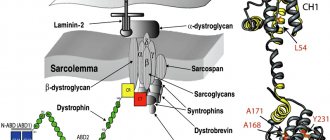Such ignorance gives rise to a huge number of misconceptions. People suffering from schizophrenia are considered dangerous to society, they are attributed with multiple personalities and a tendency to violence. But in fact, not all schizophrenics are such, and mild forms of the disorder may not be noticed by others at all.
What is schizophrenia
This is the name for a mental disorder in which there is a disturbance in thinking, self-perception, emotions and behavior. Schizophrenics do not suffer from split personality, it is a different mental disorder. This disease, first of all, makes a person stingy with emotions; he gradually withdraws into himself and stops reacting to the people around him. Main symptoms:
- Hallucinations. A person begins to see, hear and feel what is not really there.
- Rave. False beliefs and suspicions arise in the head of a schizophrenic. He claims that someone is following him, trying to harm him in some way, etc. The presence of irrefutable facts does not convince him otherwise. Sometimes a strong belief may develop that someone is stealing thoughts from your head or, conversely, putting in someone else’s.
- Behavioral disorders. A person suffering from schizophrenia may walk aimlessly from side to side, mutter something, freeze in one position for a long time, or suddenly start laughing. The appearance becomes sloppy as the schizophrenic stops taking care of himself.
- Speech organization disorders. Statements can be incoherent and are often pronounced out of place.
- Emotional disturbances. Schizophrenia is often accompanied by apathy. Facial expressions and gestures have no connection with the emotions expressed.
Manifestations indicating excessive mental activity are called psychoproductive or positive. These are thought disorders, hallucinations and delusions. The absence of normal emotional reactions, apathy, and inability to have fun are classified as the second group of symptoms - psychodeficient or negative.
To make a diagnosis, it is necessary to observe the patient for a long time. Manifestations of the disorder must be persistent and present for at least 6 months.
Types of psychopathic personality disorder
The disease is within the competence of psychiatrists. Experts combine all pathologies of this nature into two large groups:
- Excitable. The processes of excitation of the nervous system prevail over inhibition.
- Brake. A completely opposite picture is observed with the predominant processes of inhibition.
Any psychopathic personality disorder can develop gradually, the clinical picture is variable. In some cases, it is very difficult to diagnose the type of disease; for this, the doctor uses several methods - a conversation with the patient and his relatives, clinical tests, laboratory tests.
Common excitable psychopathy:
- Epileptoid.
Patients are distinguished by their desire for ideal order; they are neat and pedantic. If something disrupts their plans, it causes panic and irritation. Everything new is perceived with great fear until the patient understands what the current circumstances threaten him with. A person lives one day at a time and has no plans for the future. His mood is constantly bad, the patient is embittered, and at the same time experiences melancholy. Minimal physical activity and inertia contribute to social isolation.
- Hysterical.
Patients are characterized by changeable behavior and mood. Some circumstances arouse strong hatred in them, while others contribute to the emergence of euphoria. Emotions are not always adequate and do not in all cases correspond to a specific situation. The patient is often in a state of passion. All words and actions are pretentious and overly demonstrative.
- Paranoid.
This is a psychopathic personality disorder, accompanied by excessive willfulness and suspicion. The patient cannot control his thoughts, fears and feelings; they appear as if out of nowhere. The character becomes secretive, patients constantly think that those around them are plotting against them. It is very difficult to live in the same territory with such people. They constantly spy and eavesdrop, as if trying to find out what is being plotted against them.
Common inhibitory psychopathies:
- Psychasthenic.
A person is not confident in himself and his abilities, he is constantly afraid of everything in the world - people, events, signs. A high level of anxiety prevents you from fully engaging in professional and everyday activities. In the presence of a psychotraumatic factor, an excessively acute emotional reaction to everything connected with it is observed. Being in constant anticipation of trouble, they escalate the situation and make those around them nervous.
- Anankastnaya.
This type of disorder is characterized by the presence of obsessive-compulsive disorders. Patients create a certain ritual and follow it strictly.
- Schizoid.
A person has despotic character traits, while his emotional background is limited. The vulnerability of the individual leads to the patient being offended by others even for a minor reason. It is difficult to communicate with him, there are traits of pedantry and autism. Often, when trying to find out the essence of the conflict, such a person seems to erect a wall in front of himself. He does not want to see or listen to what he is told.
- Mosaic.
This is a complex psychopathic personality disorder, when one patient has several varieties of this pathology. The psyche has traits of changeability, symptoms often replace each other. Social adaptation in such conditions is seriously complicated.
Reasons for development
Schizophrenia, like other mental disorders, occurs due to dysfunction of the central nervous system. A malfunction occurs in certain brain structures, which leads to disruption of neural connections. They are not destroyed at all, just the commands given to the central nervous system become “incorrect”.
To date, there is no reliable information about why exactly schizophrenia develops. Most researchers believe that this disorder is hereditary. That is, the presence of people with schizophrenia in a family several times increases the likelihood of developing the disease in other family members. But so far no one has been able to identify a single “schizophrenia gene.” Most likely, there is some gene combination that makes a person vulnerable to this disorder, but does not necessarily cause it. A combination of various factors plays a major role: a person’s environment, genetics, individual characteristics of the body, etc.
Sometimes you can come across statements that a person has gone crazy from severe stress. But psychological trauma does not lead to schizophrenia; it can only give impetus to the development of the disease, if a person has such a predisposition.
The first signs of schizophrenia can be detected at different ages, but in a larger number of patients this disorder began to develop between the ages of 16 and 25 years. This period accounts for the greatest psycho-emotional load associated with adolescence in adolescence, first love, puberty and hormonal changes. All this also provokes the development of mental illnesses, to which a person has a predisposition.
Scientists also have not found a relationship between the likelihood of developing schizophrenia and belonging to a particular race, nationality, gender, etc.
The prevalence of this disorder is approximately the same throughout the world, affecting approximately 1% of the world's population.
Popular questions and answers about HIV
How does HIV manifest in men and women?
The symptoms of HIV in women are exactly the same as the symptoms of HIV in men. Manifestations may differ only at the level of genitourinary diseases, when the body is already very weakened - for example, thrush appears more often in women. Otherwise, there are no specific signs by gender.
Is there a cure for HIV?
Technically, we can say that there is no cure for HIV - patients are constantly required to undergo special therapy. But the results that it allows to achieve make the patient a healthy person who can live calmly for decades without any problems - you just need to constantly take medications and monitor your health.
HIV has not been a fatal disease for a long time!
Is HIV a disease of drug addicts and people with disordered lifestyles?
In fact, this is a myth that HIV activists are constantly dispelling. Unfortunately, a person who leads a healthy lifestyle and is responsible for their relationships can also get this disease. It is enough that a sexual partner can cheat – and in this way “bring” illness to the couple. HIV is not always a sign of an irresponsible attitude towards one’s life.
Who are HIV dissidents?
These are people who, contrary to scientific data and common sense, deny the existence of the virus. They refuse treatment, which inevitably leads to early death. Such people are also dangerous because, due to lack of treatment, they spread the virus among their sexual partners without warning them of the possible danger (because they do not believe that it exists).
The success of HIV treatment and long life lies in seeking help and starting therapy as early as possible. In this case, a person will have a long life without fears and difficulties.
Diagnostics
Schizophrenia has a wide variety of forms, so very often experts use the name of this disorder in the plural. The main symptoms, such as delusions and hallucinations, can also occur in other pathological conditions. Therefore, during diagnosis, it is very important to differentiate schizophrenia from other disorders.
To make a diagnosis, a psychiatrist uses the following methods:
1. Clinical and anamnestic examination . This examination is carried out at the first appointment. The doctor listens to the patient's complaints and examines him. Of great importance is not only the person’s condition at the moment, but also what happened to him before the onset of the disease.
Despite the fact that schizophrenia develops due to a disruption in the relationship between nerve cells, external factors (maternal pregnancy, trauma, conflicts, stress, infectious diseases, etc.) can negatively affect the course of the disease and interfere with recovery;
2. Pathopsychological examination . This diagnostic technique includes a series of tests relating to the emotional and volitional sphere of a person. The most famous is the ink blot test (Rorschach test), during which the patient is presented with 10 cards with color and black and white blots.
The Luscher test is also effective in diagnosing schizophrenia. It is based on the doctrine that a person’s perception of color depends on his psycho-emotional state.
These and other techniques allow you to assess the “unusuality” of a schizophrenic’s thinking. The fact is that the brain of a healthy and a sick person works differently. A person suffering from schizophrenia can see a whole story in a simple spot, whereas for an ordinary person it will remain a spot.
During psychological research, collections of questions are used. For example, a doctor might ask what a felt-tip pen and a boot have in common. A healthy person would be perplexed by such a question, but a schizophrenic would give the answer immediately. Such creativity in judgment is due to illness, not genius, although many brilliant people are often called crazy;
3. Neurotest and Neurophysiological test system (NTS) . In a laboratory setting, a capillary blood test (neurotest) can be performed, which helps confirm the diagnosis in doubtful cases. Thanks to it, certain markers of inflammation are detected in the blood, their number is directly proportional to the severity of the patient’s disease.
The neurophysiological test system is a modern diagnostic technique in psychiatry. During its implementation, a person’s reaction to external stimuli (light and sound) is assessed. With the help of NTS, you can accurately determine whether a person has schizophrenia or not. The use of EEG and MRI devices in these cases will be useless.
Only after a comprehensive diagnosis, a thorough examination and in full compliance with international criteria can a person be diagnosed with schizophrenia. In many cases, this requires a consultation with the participation of doctors of science and doctors of the highest category.
How is HIV diagnosed in Moscow?
There are two tests to diagnose the virus: preliminary ELISA and the most accurate immunoblot. The accuracy of ELISA is about 90%. It is recommended to carry out it 3-6 months after contact with the virus, then it gives maximum accuracy. The usual ELISA test is based on a blood test, but there are also rapid tests that help obtain information based on urine or saliva. Such texts are purchased exclusively at the pharmacy (in no case on the Internet!), since it is necessary to use officially approved products.
If the rapid test gives a positive result, you need to go to an infectious disease specialist yourself. In such a situation, as well as when ELISA in a blood test gives a positive result, the patient is prescribed an immunoblot. Its reliability is already 99.9%. Depending on the diagnosis, the diagnosis is made either on the basis of two repeated tests or a combination of both. The analysis is rechecked and only after this a diagnosis can be made. This is necessary in order to exclude false positive results that may occur during the diagnostic process.
Important: the test does not show how HIV is transmitted in a particular situation - that is, you can determine the route of infection only by analyzing your own actions.
How is schizophrenia treated?
After making a diagnosis, doctors usually move on to treatment, the main goal of which is to completely eliminate the disease and its consequences. In the case of schizophrenia, doctors’ actions will be aimed at eliminating the symptoms, because they are not able to eliminate the “problems” in the patient’s brain.
Today, the medical prognosis is disappointing – schizophrenia is incurable. Doctors have some understanding of the development process of the disorder, but they do not know how to prevent it.
However, people suffering from schizophrenia are provided with qualified specialized medical care. Usually it is carried out in several directions:
- drug therapy. Traditionally, the treatment of schizophrenia uses antipsychotics that can eliminate hallucinations. During the period of exacerbation, drugs are administered by injection, and later the patient takes tablet forms. The same medications help prevent future exacerbations. Your doctor may also prescribe sedatives, tranquilizers, or antidepressants. This is necessary to eliminate anxiety, sleep disorders and other symptoms of schizophrenia.
- psychotherapy. The work of psychotherapists is aimed at working through the patient’s psychological and behavioral problems. During the conversations, the schizophrenic will learn to manage his symptoms, which will allow him to successfully adapt to society and return to normal life.
If you ask an experienced psychiatrist the question: “Is schizophrenia treatable?”, you will get a clear answer - no. But with timely and constant therapy, the patient’s condition can be improved so much that he can lead a normal life.
HIV and AIDS - differences, duration of development, forecasts
AIDS is the final stage of HIV, which is characterized by severely reduced immunity. It is important not to confuse these two concepts. From the moment of HIV infection, the disease can develop to the AIDS stage without treatment within 9-11 years (on average). Once diagnosed with AIDS without treatment, life expectancy is short - on average up to 19 months.
If you start treatment on time, you can live a very long life at the HIV stage - the life expectancy of such patients thanks to modern treatment is 20-50 years. And although at the AIDS stage the situation is much more complicated, many patients, with proper treatment and a strong body, can live more than 10 years.
It is obvious that taking therapy is the most important factor for treating HIV and living a full, long life. Moreover, it is treatment that can significantly reduce the viral load and make the infected person harmless to the partner, as well as family members.
Rehabilitation and social assistance
Treatment in a hospital setting can eliminate acute manifestations of the disease. With stable remission, the patient can continue to stay at home and receive the necessary care on an outpatient basis. For adaptation to be successful, you must:
- teach the patient how to properly respond to stressful situations and methods of preventing relapses;
- restore an adequate perception of the surrounding reality;
- tell the patient, his family members and close people about the disease, the features of its occurrence and course;
- normalize the functioning of memory and thinking, make it adequate;
- prepare the patient for the need to study and work.
Remission in schizophrenia can be indefinitely long, provided that the patient continues the course of maintenance drug therapy and psychotherapy. The support of loved ones, their care, love and attention is of great importance.
HIV treatment
Treatment boils down to prescribing antiretroviral therapy. The patient is given a medication regimen - and it must be followed as precisely as possible, without deviating from the program. Otherwise, the virus may develop resistance to treatment and cannot be further suppressed.
Indicators of quality treatment are a decrease in the viral load, as well as an increase in CD4+ cells in the blood, which indicates the activity of the immune system.
Medicines for treatment are issued in medical institutions, patients are registered and receive medications free of charge, in accordance with the established procedure. Information about the disease is confidential - it is not sent to work, place of study or other places. The patient has the right to keep it secret (if this is not provided for in separate work contracts).
If the rules for taking therapy are followed, the virus in the blood gradually decreases; over time, the patient becomes completely safe for his sexual partner and is not able to infect anyone.
Myths about schizophrenia
Many myths have been created around schizophrenia, since this mental disorder scares people no less than AIDS or cancer. The most common misconceptions are the following:
1. All people suffering from schizophrenia are violent and dangerous, they belong in a special hospital. This myth is due to the fear of the unpredictability of mentally ill people in general and schizophrenics in particular. Cases of violence by the mentally ill receive too much publicity in the press, resulting in the impression that all “psychics” are dangerous.
In fact, people with schizophrenia are more likely to harm themselves than others. According to statistics, a much larger number of crimes are committed by persons under the influence of alcohol, but people who abuse alcohol are not isolated from society. Schizophrenics can lead completely normal lives if they follow the recommendations of their doctor.
2. The diagnosis of schizophrenia implies dementia and complete disability. It can be very difficult for people with various mental disorders to organize their own lives, but with the support of loved ones they can cope with the destructive influence of the disease. As for intellectual abilities, they are no higher or lower than those of healthy people.
Schizophrenia affects the way of thinking, not intellectual development. For example, John Forbes Nash Jr., who suffered from schizophrenia, learned to ignore his disorder. He became famous for receiving the Nobel Prize in Economics (1994). The film “A Beautiful Mind” was made about the life of this American mathematician.
3. Parents are to blame for the development of the disease. Modern research confirms that schizophrenia may be caused by heredity. However, genetic factors are not fundamental and the only ones that can influence the course of the disorder.
Its relationship with incorrect communication models in the family, pedagogical neglect and improper upbringing has not been established. Although an unfavorable environment can have a negative impact on the healing process, it cannot be considered the main cause of the development of schizophrenia.
4. Creative and brilliant people suffer from schizophrenia. Indeed, history contains many examples of great artists, poets and musicians suffering from various mental disorders. The artist Vincent Van Gogh and the writer N.V. Gogol were schizophrenics; it is attributed to Isaac Newton, Albert Einstein and other famous people. But the talents of these people have nothing to do with mental illness.
People with schizophrenia can demonstrate the same talents, strengths and weaknesses as a healthy person.
Another myth about schizophrenia is the persistent belief that this disorder does not need to be treated. It has already been mentioned several times above that schizophrenia cannot be treated. The point is that pathological changes in the human brain are irreversible. But modern medicine is able to help a sick person cope with the negative manifestations of schizophrenia, which can greatly complicate life for both himself and his loved ones.
Is drug addiction curable?
Modern rehabilitation centers show quite optimistic results: their patients of yesterday restore relationships with relatives, find work and boldly look to tomorrow with absolutely clear eyes.
However, the answer to the question of whether drug addiction can be cured is not so clear-cut. Too much depends on the patient himself, his loved ones, and the correctness of the chosen treatment strategy.
One thing is certain: drug addiction treatment is a long, complex process that requires constant monitoring by professional narcologists and psychologists. Don't waste your time on dubious methods that promise instant healing. Only an integrated approach will help.
The question whether it is possible to completely cure a drug addict must be asked by the addict himself. Recognizing the problem is the very first step, without which further treatment is pointless. The support of loved ones is no less important: they are the first to notice changes in the behavior and health of a person who is addicted to drugs. It is they who are entrusted with the task of convincing the drug addict to begin the fight for a healthy future as early as possible.
It cannot be done without medical intervention. When psychoactive substances have already become integrated into the body’s metabolic processes, drug support becomes the only way to save a person from death as a result of overload of the cardiovascular system. Later, psychologists will join in and take on the most lengthy and painstaking work to create a sustainable motivation for the addict to recover and search for new meanings in life.
Assistive treatments for schizophrenia
Today you can find a lot of advertisements about non-traditional methods of treating various mental disorders, including schizophrenia. Patients are offered remedies prepared from medicinal herbs by monks or developed in secret laboratories by super-scientists.
You can also buy a device on the Internet that will restore the affected areas of the brain. But all this is just another attempt by enterprising businessmen to make money on someone else’s misfortune. It is not possible to cure schizophrenia using these methods, although herbal medicines will have a general strengthening effect on the body.
If we talk about auxiliary methods of treating schizophrenia, the most effective may be:
- art therapy. Practicing various types of art has a beneficial effect on the psyche. When working with schizophrenics, music and drawing classes are most often used;
- family therapy. During group sessions, assistance is provided not only to the patient himself, but also to his family members. A healthy person often also needs psychotherapeutic help, because living next to a sick person is not at all easy;
- Alternative medicine. It is unlikely that you will be able to get rid of schizophrenia with the help of acupuncture, yoga, or breathing exercises. But with the right approach, you can forget about its manifestations;
- group therapy. Schizophrenia makes a person withdrawn and distrustful, which is why many psychotherapists practice so-called communication therapy. A special group is being created, which includes both schizophrenics and healthy people. First, patients communicate with others like themselves, and then try to build relationships with the rest of the meeting participants. Everyone benefits from such communication: schizophrenics acquire communication skills, and healthy people learn tolerance and tolerance when communicating with a mentally ill person.
If you use the above methods of treating schizophrenia together with psychotherapy and taking medications prescribed by your doctor, you can almost completely eliminate the symptoms of the disease.
Signs of different types of schizophrenia in men
The disease manifests itself in various symptom complexes, everything depends on its stage, form and speed of development. There are a number of differences between personality changes in women and men.
The following signs are typical for representatives of the stronger sex:
- the course of the disease is more severe, in a complex form;
- the patient becomes withdrawn, emotionally cold, loses social attachments and completely ignores moral principles.
It is not always possible to conduct a full diagnosis based on the first signs of schizophrenia. In men, the disease often occurs continuously and progresses slowly, gradually revealing classic symptoms.
By the time a diagnosis is made, schizophrenia has usually already reached a progradient-offensive period, during which moments of exacerbation alternate with unstable remission. In addition, male schizophrenia is often complemented by binge alcoholism.
The initial stage of the disease is not demonstrated by typical schizophrenic hallucinations, delusions, and the appearance of obsessive states. However, the mechanism of personality disintegration is triggered.
The initial signs of schizophrenia manifest themselves in schizotypal disorder: fear of social relationships, manifestations of anxiety, aggressiveness, and eccentric behavior. A very dangerous form of the disease, as it is diagnosed already at the stage of increasing progress.
The hebephrenic form of schizophrenia allows the patient to some extent retain even long-term memory, and this gives him the opportunity to control the thinking process. It is characterized by the appearance of foolishness, emotional flatness or inadequacy and impaired thinking in the form of broken speech. This form is not usually dominated by delusions and hallucinations, although they may be present in a mild form.
The sick person often falls into a state of extreme aggression, while (as an adult) demonstrating the complete failure of actions and decisions. He becomes emotionally labile and requires constant outside control.
Doctor's advice
Quitting alcohol and psychotropic substances improves the prognosis. If you suspect schizophrenia, a man should not only consult a psychiatrist, but also stop drinking any alcoholic beverages or using illegal drugs.
Victoria Druzhikina Neurologist, Therapist
Symptoms of catatonic schizophrenia: stupor, agitation, negativism, freezing, waxy flexibility, automatic execution of punished instructions (subordination). Both the active phase and catatonia pose a danger not only to the patient himself, but also to those around him.
Patients with this diagnosis are forcibly placed in psychiatric hospitals. Schizophrenic men behave like capricious children, but at the same time their physical strength is several times greater than that of healthy representatives of the gender.
Paranoid schizophrenia is easily identified by the characteristic symptoms of mental disorders: delusions and states, hallucinations, obsessive neuroses. The patient usually refuses social contacts, is constantly immersed in personal experiences and is closed in the inner world. In moments of exacerbation, the patient is hospitalized in a psychiatric hospital.
Paranoid schizophrenia is regarded as the most favorable prognosis for recovery.
The simple form of schizophrenia is a slowly progressive type of illness. At the same time, symptoms of alienation, apathy, solitude, an asocial lifestyle, and a decrease in educational and work productivity increase. Concentration on one idea while abandoning previous interests, hobbies, sloppiness, neglect of personal hygiene.”
During the course of the disease, symptoms may undergo some changes, but in general, schizophrenia is identified by:
- Paranoid states. The sick person is sure that he is being hunted, he is being pursued, there are intrigues and conspiracies everywhere around him, and his life is controlled by government services, otherworldly creatures or aliens. Along with this, a schizophrenic can position himself as a representative of a superior race, invent non-existent love or friendship, and equate himself with messiahs.
- The presence of hallucinations. The patient hears voices forcing or ordering him, urging him to take actions of an antisocial nature. All hallucinations that insist on actions performed against the will of the patient themselves are called pseudohallucinations. Since the patient is convinced that he is the chosen one and no one else is able to accept and manage the information coming to him.
- Illogical behavior and way of thinking. The patient's speech is often incoherent. Phrases are constructed deliberately pretentiously, pathetically.
- Clear signs of persecution mania.
- Inappropriate behavior in a familiar environment.
- The desire for social isolation.
- Emotional lability or emotional inadequacy.
- Complete disregard for personal hygiene rules.
- Constant clumsiness, loss of orientation in the surrounding space.
Features of the manifestation of schizophrenic symptoms in men depend on the degree of degradation and destruction of personality, the reactivity of nervous processes, and the individual emotional spectrum.











